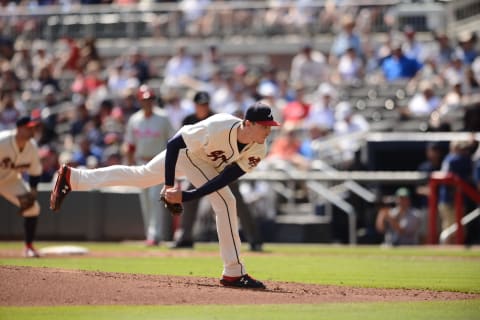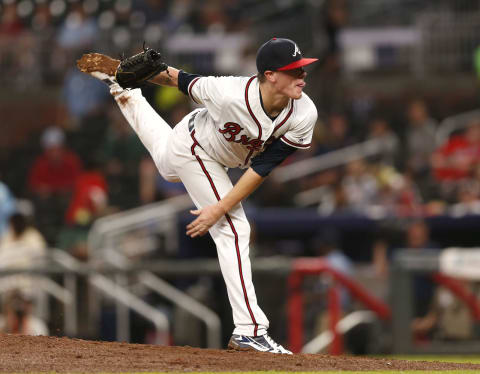Atlanta Braves 2018 Minor League Review: Left-handed starters


With the minor league season complete, it’s time to take a look back at the performances in the Atlanta Braves system this year.
With the major league club reaching success, many Atlanta Braves fans have shifted their focus from the intense scrutiny of the minor league system that was the norm for the last few seasons to a more concerted cheering for the big league squad – and that’s expected. However, there were some very notable things to happen in the minor league system this year, so it’s definitely worthwhile to review all that happened!
This will part of our positional reviews here at Tomahawk Take. We will begin with catcher and work our way through the infield, outfield, right-handed starters, left-handed starter, and relievers. Finally, we will announce our Tomahawk Take 2018 Atlanta Braves organizational team of the year and team awards. That will all lead up to the top 100 prospect list that will once again appear on this page after a year’s hiatus while our Benjamin Chase was working with other sites (though he did produce a top 100 last season, just not with TT!).
We will have the schedule as such:
Catchers
Corner Infielders
Middle Infielders
Outfielders
Right-Handed Starters
Left-Handed Starters
Right-Handed Relievers
Left-Handed Relievers
We’ll then move with our awards, including the minor league All-Star team and player/pitcher of the year. So, let’s take a look at the left-handed pitchers in the Atlanta Braves system…
Position review
While Sean Newcomb carried the load for lefties with the Atlanta Braves at the big league level this year, the Atlanta Braves were lauded coming into the season for their depth of left-handed pitching. The depth of top arms from the left side is incredible and unique in the game.
Of course, that doesn’t mean that the Atlanta Braves have as many left-handed starting prospects as they have from the right side – that’s just not feasible. However, the ability to find and develop top lefty arms is absolutely a strength thus far, and it should serve the future rotation very well for the Braves.
As the “studs” reached the majors this year, guys who were in the next wave of lefty arms began to shine through, and now Braves fans will have plenty to follow going forward.
Let’s dig deeper into those players!

Upper minors
The guy who drew the most divisive attention this year was former top pick Kolby Allard, the Atlanta Braves first selection in the 2015 draft. Allard was pushed up to AA in 2017 and didn’t blink, so when he was promoted again to AAA at 20 to open 2018, most thought he’d again excel, and statistically, he absolutely did. His final line for Gwinnett was a 2.72 ERA and 1.21 WHIP over 112 1/3 innings, posting a 34/89 BB/K ratio. However, Allard’s velocity had settled into the low-90s, requiring Kolby to rely on his premium location and sequencing for success. He absolutely showed an ability to do exactly that at the AAA level, though he may end up being more of a #4 starter than a #1/2 starter.
One of the top Braves arms that could end up having a career in the bullpen or rotation, Max Fried is the last piece left from the original Justin Upton deal. The combination of his mid-90s fastball and premium curve has allowed Fried to have success, posting a 3.94 ERA and 1.34 WHIP over 77 2/3 innings with 34/87 BB/K ratio in the minors along with a 2.94 ERA, 1.37 WHIP, and 20/44 BB/K over 33 2/3 innings in the majors, working 14 games, 5 of them as a starter. Whether as a back-end starter or a reliever, Fried should factor into the Braves roster for 2019.
If anyone in the entire Atlanta Braves organization would like a do-over on the 2018 season, it’d be Luiz Gohara. Family health issues, loss of family, and personal health issues marred Gohara’s season, and he was never able to replicate his brilliant first season in the Atlanta Braves system. Over the year he posted a 4.81 ERA in 58 innings with 59 K’s in the minors and a 5.95 ERA with 18 K over 19 2/3 innings in the majors. Gohara has a legit 70-grade fastball and 70-grade fastball, if not better, from the left side. That will get him plenty of opportunities.
After spending much of 2017 as a swingman for Mississippi, Michael Mader was a starter for the majority of his 2018, pitching between AA and AAA, making 30 appearances, 16 of them starts, as he tallied 102 innings at a 3.71 ERA, 1.53 WHIP, and a 53/85 BB/K ratio. Mader is not a guy who will overpower, and the swingman role is his likely path to the big leagues if he makes it there.
The third high school arm taken in the 2016 draft, Kyle Muller very well may have been the most athletic, a legit two-way star that had a full-ride offer to play first base and pitch in college. The big Texan jumped up both A-ball levels and finished his 2018 in Mississippi, and his advanced feel made that a very logical ascension as he seemed right at home in the moment. In total, Muller made 25 starts, tossing 139 2/3 innings, with a 3.03 ERA, 1.23 WHIP, and a 46/129 BB/K ratio.
Put on the 40-man roster last offseason to protect his raw talent, Ricardo Sanchez struggled through injury this season, but when he was on the mound, he showed his potential mid-rotation stuff, making 16 starts, tossing 73 2/3 innings, with a 3.79 ERA, 1.45 WHIP, and a 28/57 BB/K ratio. He’ll still just be 21 when the season opens in 2019.
A-ball
The Atlanta Braves second pitch in the 2016 draft out of high school in Kansas, Joey Wentz got a lot of predraft concern due to his velocity not being what he had shown in showcases, though he had never pitched full-time until his senior year. He’s not picked up a ton of velocity from his draft season, but he’s learned to be a tremendous pitcher, and that could be huge for him going forward.
Wentz battled around injuries this season, but when he was on the hill, he was tremendous, posting a 2.28 ERA, 1.09 WHIP, and a 24/53 BB/K over 67 innings. Wentz will get his first taste of the upper minors next season at 21 years old.
Coming into 2018, Tucker Davidson was getting plenty of note for his performance in the 2017 season, when he moved into the rotation to finish the season and posted a 2.60 ERA over the season. Davidson struggled out of the gate in 2018, but if you take out his disastrous April, Davidson’s numbers began to look very much like 2017.
From his first May start on May 4th through the end of the season, Davidson made 19 starts, tossing 100 2/3 innings, with a 3.31 ERA, 1.34 WHIP, and 40/85 BB/K. He finished out the year even stronger in the final month as most guys are usually wearing down, posting a 2.33 ERA, 1.19 WHIP, and 11/32 BB/K ratio over 27 innings in August.
The small Nicaraguan lefty, Dilmer Mejia has spent four seasons in rookie ball before finally busting out in 2018, though his performance in full-season leagues was not exactly what the team would hope. Still just 21 when the 2019 season opens, Mejia looked very good with Danville before struggling with Rome and Florida. Overall, he posted a 3.99 ERA, 1.45 WHIP, and 33/71 BB/K ratio over 90 1/3 combined innings.
Rookie Ball
An Atlanta Braves signature “late sign”, Miguel Jerez has shown exceptional polish in rookie ball thus far, though he’s been advanced in age for each level so far due to being signed at 18.
Jerez had 13 appearances in 2018, with 11 of them starts. He posted a 4.45 ERA, 1.29 WHIP, and 10/52 BB/K ratio over 60 2/3 innings. He does not have elite velocity, relying on his change and location as his primary weapons, and that sub-4% walk rate is incredibly impressive, even if it’s likely to profile as a back-end starter or swingman.
The Atlanta Braves 21st round pick this summer, Tanner Lawson was able to make 13 appearances, 11 of them starts, all for Danville, posting a 3.68 ERA, 1.13 WHIP, and 5/31 BB/K ratio over 29 1/3 innings. His excellent command and control played well in the Appy League, but it will be interesting to see how his lesser velocity plays in full-season ball.
More from Braves Minors
- Why the Atlanta Braves would be foolish to sign a starter
- Braves prospects Cal Conley and Justyn-Henry Malloy on the ballot for Arizona Fall League All-Star Game
- Six Atlanta Braves Prospects who could break out in 2023
- Braves Prospects: MVP and Cy Young for Augusta GreenJackets
- Atlanta Braves Able to Sign All 22 of their 2022 MLB Draft Picks
Standing 6’1″ with surprisingly long limbs, Filyer Sanchez works primarily with two pitches, a high-80s fastball and a low-70s curve, but he does have high-70s change that he rarely tosses in as well. Filyer’s long limbs would allow him to work in the bullpen as he hides the ball well before delivering, which allowed him to put up a 4.94 ERA, 1.37 WHIP, and a 21/38 BB/K ratio over 58 1/3 innings.
Finally working his way out of the DSL after being a late signee, Lisandro Santos made 15 appearances, 8 of them starts, throwing 49 1/3 innings, with a 4.20 ERA, 1.60 WHIP, and a 32/49 BB/K. Santos is not known for big velocity, but his breaking stuff is wicked if he can keep it in the zone.
Next. The top 15 leadoff seasons in Braves history. dark
Left-handed pitchers are of extreme value, especially those who can make starts. The Atlanta Braves have put together a tremendous depth of arms from the left side that could give them multiple options as a future rotation piece at the big league level.